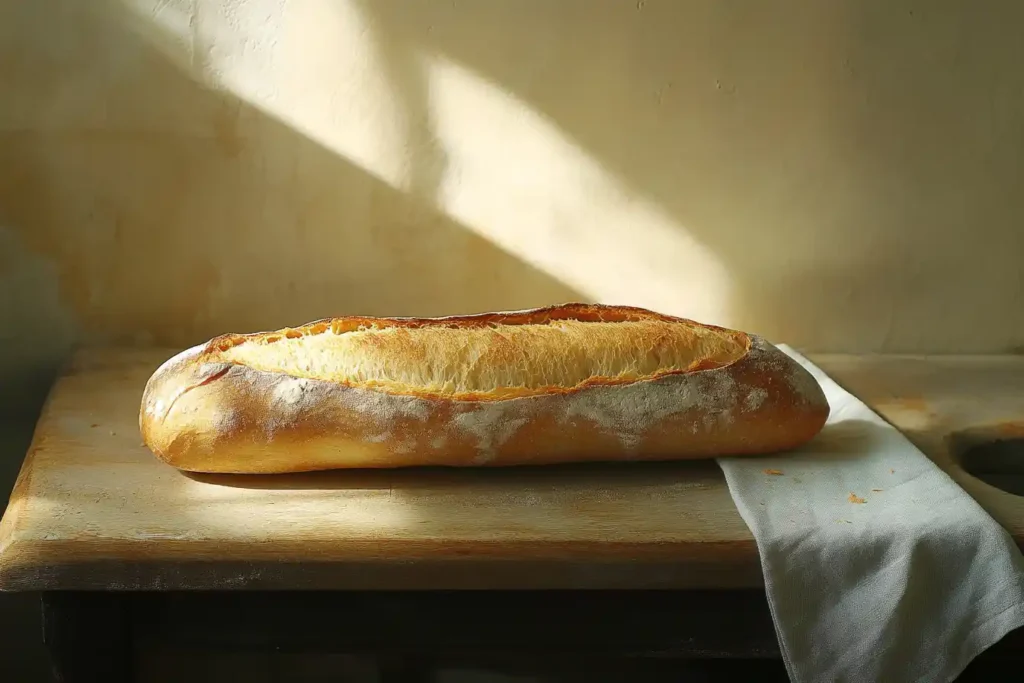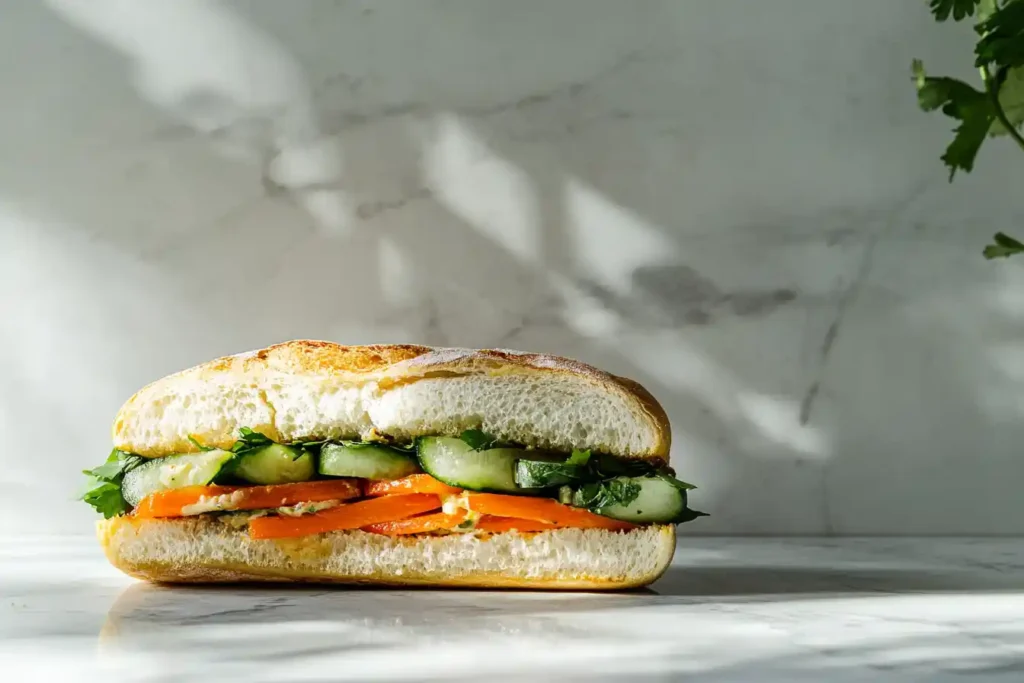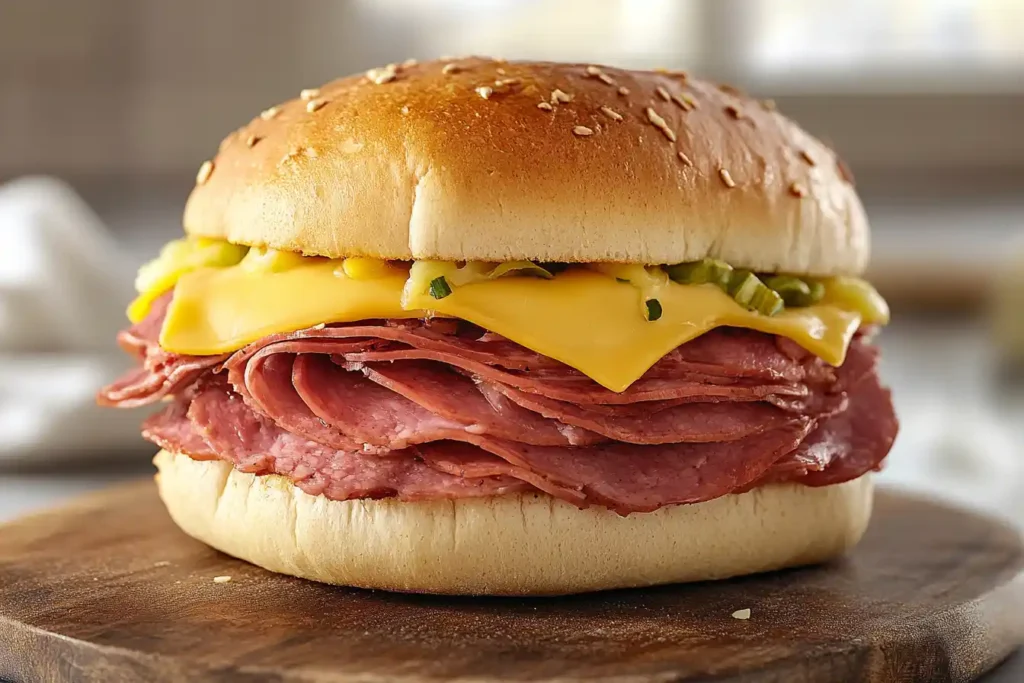Introduction to Long Bread Rolls
At its core, a long bread roll is exactly what it sounds like—a bread roll that is elongated rather than round or oval. These rolls can range from soft and fluffy to crusty and chewy. What makes them so versatile is their size and shape, perfect for holding delicious fillings or enjoying plain. Many types are enjoyed with savory or sweet pairings, making them a global favorite.
But what really sets a long bread roll apart from other types of bread? Well, it’s all about the dough and the baking technique. For example, a baguette has a crunchy crust with an airy interior, while a hoagie roll is soft, slightly dense, and ideal for hefty sandwiches.
Historical Origins of Long Bread Rolls
The history of the long bread roll is as varied as its names. Bread, in its earliest forms, has existed for thousands of years, but elongated rolls became more prominent with the rise of portable, on-the-go meals. France’s iconic baguette gained prominence in the 19th century when regulations mandated longer bread shapes that were easier to tear and share.
Interestingly, the Vietnamese bánh mì came about during the period of French colonization, blending local flavors with the structure of the French baguette. Meanwhile, in America, the hoagie roll emerged in the early 20th century, beloved by factory workers who needed a quick but filling meal.
These long bread rolls tell the story of migration, adaptation, and innovation.From Parisian cafés to bustling Vietnamese street vendors and Italian delis in the U.S., each region has put its stamp on the humble roll, as noted in this long bread guide. Now, let’s dive into the most popular types of these elongated breads and what makes each one special.
Types of Long Bread Rolls
Baguette

When most people think of a long bread roll, the baguette is probably the first thing that comes to mind. Known for its crunchy crust and soft, airy interior, the French baguette is synonymous with simplicity and culinary excellence. Its name literally means “wand” or “stick” in French—a fitting description for this elongated bread.
The baguette has a storied history dating back to the 19th century. It became more prominent after 1920, when a French law restricted bakers’ working hours, encouraging the creation of a bread type that baked quickly. This iconic bread is often enjoyed as part of a traditional French breakfast, paired with butter or jam. It’s also central to France’s lunchtime staple, the jambon-beurre (ham and butter sandwich).
But the baguette isn’t just a French treasure—it’s beloved worldwide. From artisan bakeries to local supermarkets, its signature crackling crust makes it hard to resist. Its cultural significance even earned it a place on UNESCO’s intangible cultural heritage list in 2022, reinforcing its importance as more than just food—it’s a symbol of French heritage and pride.
Bánh Mì

The Vietnamese bánh mì is a perfect example of culinary fusion. While its form is inspired by the French baguette, its fillings burst with vibrant Vietnamese flavors. After the French colonized Vietnam in the 19th century, they introduced their beloved bread to the region. Over time, the Vietnamese put their own spin on it, creating a bread roll with a slightly thinner crust and fluffier interior.
What truly sets bánh mì apart is how it’s served. These long rolls are typically stuffed with savory ingredients such as marinated pork, pickled vegetables, cilantro, and a generous spread of pâté or mayonnaise. The balance of tangy, salty, and sweet flavors makes bánh mì a beloved street food staple around the world.
Today, bánh mì isn’t just a local favorite—it has gained global acclaim as an affordable, flavorful meal. You can find these rolls in food trucks, cafés, and restaurants in cities from New York to Sydney. Its enduring popularity proves that a simple long bread roll can tell a story of cultural exchange and culinary creativity.
Hoagie Roll

If you’re in the U.S., particularly on the East Coast, you’ve likely encountered the hoagie roll. This soft, slightly chewy bread roll is the backbone of countless hearty sandwiches. Originating in Philadelphia, the hoagie roll became famous as the preferred vessel for the hoagie sandwich—a sub filled with deli meats, cheeses, lettuce, tomatoes, and condiments.
But where did the name “hoagie” come from? There are a few stories, but the most popular one suggests it originated in the early 20th century when Italian-American workers at the Hog Island shipyard needed a satisfying lunch. Local delis began selling large sandwiches packed into soft rolls, and the term “hoggie” (later “hoagie”) was born.
The hoagie roll stands out due to its durability—it holds up well against hefty fillings without becoming soggy. From classic Italian hoagies to creative modern twists like vegan hoagies, this bread roll remains a staple in sandwich culture. Its versatility and size make it a top choice for a meal that can fill you up without falling apart.
Pão Francês

In Brazil, the long bread roll known as pão francês (literally “French bread”) is a breakfast favorite. Although it shares similarities with the French baguette, pão francês is shorter, lighter, and often has a slight golden sheen due to a unique baking process that involves steam. The result? A crust that’s delicately crisp and a soft, airy center.
Pão francês first gained popularity in Brazil in the early 20th century when French-inspired baking techniques made their way across the Atlantic. Bakers began experimenting with variations that catered to local tastes. Today, the roll is often eaten for breakfast, sliced open and filled with butter, cheese, or ham. In many households, a morning isn’t complete without pão francês served with a piping-hot cup of café com leite (milk coffee).
In addition to its role in breakfast, pão francês is also a go-to choice for sandwiches during lunch and dinner. Whether enjoyed plain or packed with savory fillings, this long bread roll holds a cherished place in Brazilian cuisine. Its simple ingredients—flour, water, yeast, and salt—remind us that even the most unassuming foods can bring comfort and joy.
Regional Variations and Names
United Kingdom
In the UK, long bread rolls may seem straightforward, but their names change dramatically depending on the region you’re in. A long bread roll might be called a bap, cob, bun, or even a barm cake. Confusing? Definitely—but also fascinating!
In Northern England, particularly in places like Manchester, the term barm cake is common. Meanwhile, in the East Midlands, cob is the word of choice, while in Scotland and parts of Northern Ireland, you’ll likely hear bap. All these names refer to rolls of varying textures—some are soft, others more crusty—but they’re all used to cradle delicious fillings, from sausages to fried eggs.
Interestingly, some of these names have historical roots. The term barm comes from the foam that rises during fermentation, which was traditionally used in breadmaking. Meanwhile, bun is more general and can refer to both sweet and savory rolls. Despite the many names, the love for bread rolls as a lunch or snack staple unites all regions of the UK. Whether you’re having a bacon bap or a cheese cob, one thing is certain: long bread rolls have become an essential part of British culinary identity.
United States
In the United States, long bread rolls go by a dizzying array of names, depending on the state or city you’re in. You’ve probably heard the term sub roll, which is short for submarine sandwich. This term became widespread because of the roll’s elongated, submarine-like shape. But that’s not the only name! In New York, you’ll likely hear hero roll, while in New England, grinder roll is a popular term for the same type of bread.
Hoagie roll—as mentioned earlier—is especially common in Philadelphia, and po’ boy roll dominates the Louisiana culinary scene. The distinctions are more than just linguistic—they often hint at the type of sandwich served on the roll. A po’ boy roll, for instance, has a slightly more delicate crust to pair well with fried shrimp or roast beef.
Despite the differences in names and small variations in texture, most of these long rolls share a similar purpose: to hold an overstuffed, savory sandwich. From delis to diners, these long bread rolls form the backbone of iconic American comfort food. Whether you’re craving a meatball sub or a turkey hero, the roll plays a starring role in delivering that satisfying bite.
France
France may be famous for the baguette, but it doesn’t stop there—this country takes its bread very seriously. Two lesser-known variations of the long bread roll are the ficelle and the batard. Both are beloved in French bakeries and offer unique differences in size and texture.
The ficelle—which means “string” in French—is a thinner and more delicate version of the baguette. Its slender form makes it perfect for light snacking, often paired with soft cheese or pâté. It’s crispier due to its smaller size, giving a satisfying crunch with every bite.
On the other hand, the batard is a shorter, wider cousin of the baguette. Its shape is slightly oval and more robust, making it ideal for heartier sandwiches. This long roll has a slightly denser crumb, which holds up well against fillings like roasted vegetables or cured meats.
Whether it’s the classic baguette, the slim ficelle, or the stout batard, French long bread rolls showcase a deep appreciation for the art of baking. Each roll has its role in French gastronomy, highlighting the country’s passion for simple, high-quality ingredients.
Italy
Italy is home to some of the most flavorful long bread rolls, including the filone and ciabatta. The filone, which translates to “thread” or “cord,” is a long, rustic Italian bread roll with a crusty exterior and a chewy, open crumb. It’s perfect for dipping in olive oil or making hearty sandwiches with ingredients like cured ham, mozzarella, and fresh basil.
The ciabatta—arguably the most famous Italian long roll—is known for its irregular, airy texture and soft interior. Created in the 1980s as a response to the French baguette, the ciabatta quickly gained popularity for its versatility. Its name means “slipper” in Italian, a reference to its flat, somewhat elongated shape.
Both filone and ciabatta have become staples in Italian households and beyond.While filone is often used for everyday meals, ciabatta has gained international fame as a premium sandwich bread. In fact, it has become a staple on menus worldwide.
Whether topped with grilled vegetables, layered with prosciutto, or filled with melted cheese, Italian long bread rolls shine in every recipe. They remain a beloved canvas for both simple and bold flavors.
Nutritional Facts for Italian Long Bread Rolls (Per 100g)
| Nutrient | Amount |
|---|---|
| Calories | 270 kcal |
| Carbohydrates | 54 g |
| Protein | 9 g |
| Fat | 3 g |
| Saturated Fat | 0.5 g |
| Fiber | 2 g |
| Sodium | 380 mg |
Cultural Significance and Usage
Culinary Applications
Long bread rolls have secured a vital place in cuisines worldwide. They often serve as the foundation for countless beloved dishes.
For instance, in France, the baguette is a staple at nearly every meal. It appears during simple breakfasts with jam and butter and reappears at dinner alongside stews and cheese.
Meanwhile, in Vietnam, the bánh mì has become a global sensation. This sandwich blends tangy pickled vegetables, savory meats, and creamy spreads—all tucked inside a crispy, airy roll.
The United States, long bread rolls take center stage in iconic sandwiches like the Philly cheesesteak, meatball sub, and Italian hoagie. These rolls are built to hold bold flavors and overflowing toppings. Meanwhile, in Brazil, pão francês serves as the perfect complement to soups and is often enjoyed with a simple filling of cheese or ham.
In Italy, ciabatta has become a favorite for panini, pressed with fresh ingredients like tomatoes, basil, and olive oil. Even in Middle Eastern cuisines, long rolls are used as substitutes for flatbreads in some modern dishes. Clearly, these versatile bread rolls are as diverse as the cultures that enjoy them.
Symbolism and Traditions
Long bread rolls carry deeper meanings in certain cultures, often symbolizing community, tradition, and sharing. In France, tearing apart a baguette at the dinner table is a symbolic act of togetherness—a communal experience passed down through generations. It’s not just about eating bread; it’s about participating in a ritual that reinforces bonds among family and friends.
In Vietnam, the bánh mì holds historical significance as a symbol of cultural fusion, representing resilience and adaptation during a time of colonial influence. Today, it serves as a reminder of how Vietnamese cuisine has thrived by embracing and reimagining external influences.
In Brazil, pão francês is associated with morning routines and family breakfasts, evoking feelings of comfort and nostalgia. Meanwhile, in Philadelphia, biting into a classic hoagie isn’t just about the sandwich—it’s about celebrating local pride and tradition, especially during sports events or city festivals.
These traditions show that bread rolls aren’t merely vessels for food—they are cultural touchstones that tell stories of migration, survival, and celebration.
Modern-Day Popularity
Long bread rolls have soared in popularity in recent years, thanks to their adaptability and timeless appeal. Artisan bakeries have elevated classics like the baguette and ciabatta by experimenting with ingredients such as whole grains, seeds, and sourdough starters.
In street food culture, bánh mì shops and food trucks have emerged worldwide, catering to fans of bold flavors. Similarly, fast-casual chains have embraced long rolls for gourmet sandwiches. This trend further proves the enduring appeal of these flavorful breads. Moreover, these breads remain a beloved staple in contemporary cuisine. The humble long bread roll has transcended its origins and become a universal culinary icon. Above all, it unites people through the simple joy of great bread.
Frequently Asked Questions About Name of the Long Bread Roll
What is the difference between a baguette and a ficelle?
A ficelle is thinner and more delicate than a baguette, with a crispier crust due to its narrow shape. While a baguette is versatile enough for sandwiches or as a meal accompaniment, a ficelle is often enjoyed as a light snack with spreads or cheese.
Why are there so many regional names for bread rolls in the UK?
The UK’s wide variety of bread roll names stems from historical and cultural differences across regions. Local dialects and traditions influenced the terminology, leading to terms like bap, cob, and barm. These regional distinctions reflect the diverse culinary heritage within the UK.
How did the Vietnamese Bánh Mì develop from the French baguette?
The bánh mì originated during French colonial rule in Vietnam, when locals adopted the baguette. Over time, they modified it to have a lighter crust and softer crumb, then filled it with local ingredients like pickled vegetables and marinated pork, creating the flavorful street food icon we know today.
What makes a hoagie roll different from other sandwich rolls?
Hoagie rolls are typically softer and slightly chewy, designed to hold dense fillings like deli meats, cheeses, and sauces without falling apart. Unlike crusty rolls like baguettes, hoagie rolls offer a balance between structure and softness, making them ideal for overstuffed sandwiches.
Conclusion Of Name of the Long Bread Roll
Long bread rolls are more than just bread—they’re culinary icons that have shaped meals across the globe. From the crusty baguette to the soft hoagie roll, each variation tells a unique story of tradition and adaptation. Additionally, the flavorful bánh mì highlights local flavors that reflect cultural heritage. This diversity in names, types, and cultural uses shows how bread, though simple, fosters individuality and unity. For example, whether you enjoy a sandwich, dip it in soup, or share it at a family meal, bread brings people together. Ultimately, these long rolls remind us of the universal comfort found in good bread.

